Steel liquidators
In the case of natural or man-made disasters, tanks are often used to break up debris and on large fires. Converted into civilian versions, with weapons removed, they are used as all-terrain vehicles, tractors, harvesting and grader equipment, as well as to penetrate hard-to-reach places in conditions of fire spreading or under the threat of collapse of structures. For the latter task, the tank was also used when working in the Shelter, built over the destroyed 4th power unit of the Chernobyl nuclear power plant.
The engineers who created the prototype dismantled the tower, installed a dosimeter, a temperature sensor, and an illuminator on the tank. The tank was equipped with a remote control, which was carried out by electric cable, in the same way received data from the installed tools. From the very first attacks, the tank proved to be very useful for radiation reconnaissance: launching it ahead of people, it was possible to inspect structures and measure the level of radioactive contamination promptly and without unnecessary risk for the liquidators. In addition, the car was very maneuverable and passable due to its small size, crawling among the rubble into the smallest and most inconvenient passages, and the plastic case was easily susceptible to subsequent cleaning and decontamination.
The tank was a toy, and it was one of the most successful robots created and applied at the emergency station.
')
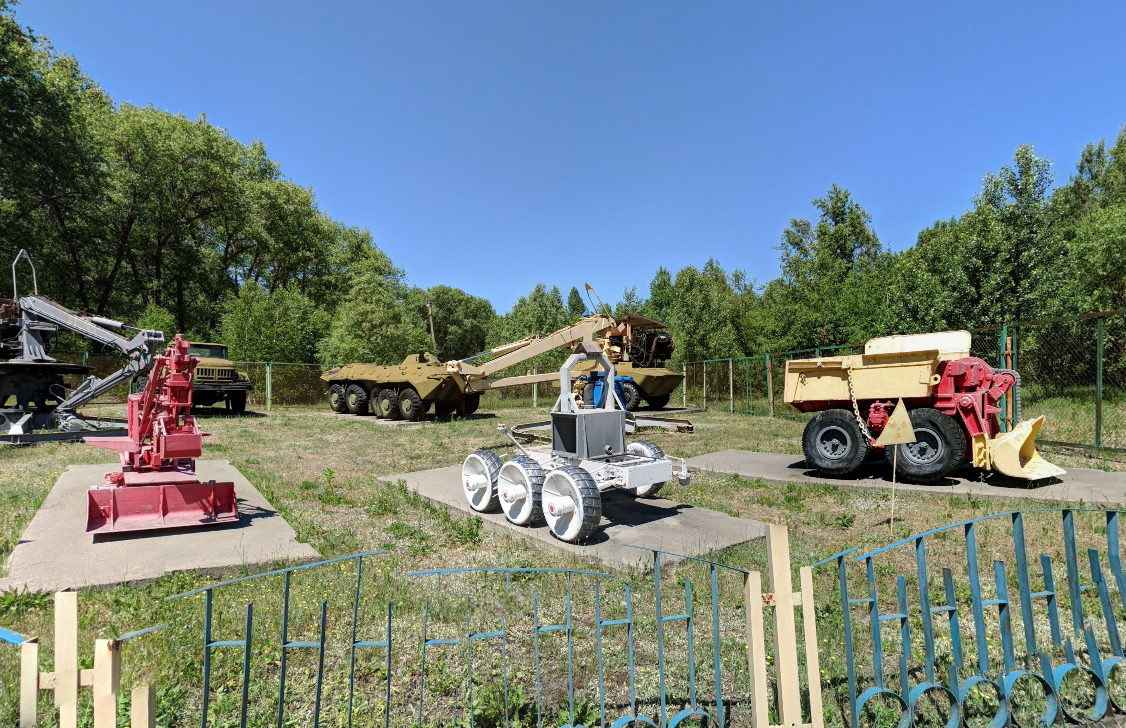
There is such an Internet meme: at first glance, innocuous pictures with the caption "When you notice THIS - get it by fear."
In the photo above ( link to the source and the author ) everything seems cute: red, seemingly toy excavator is a childhood dream; the same dump truck: like a toy, but big and serious; between them is a silvery moonwalker. Probably, this is a playground of some school or summer camp, and the armored personnel carrier in the background is well, for patriotic education.
But no. The very “frightening detail” in the photo is a small triangular sign of radiation danger in front of a dump truck. This is the exposition of a small museum of equipment that took part in the liquidation of the accident , and the sign eloquently shows why the exhibits cannot be touched.
There is an opinion that when trying to use robots, they all very quickly failed, they chose to give up, and they began to clean the emergency station with "bare hands", that is, at the cost of the health and lives of numerous liquidators. In fact, this is a very controversial statement, with the direct participants in those events arguing among themselves. Indeed, directly during the work of extinguishing, cleaning the roof, decontamination and dismantling of debris robots could not fully replace people. They had their own serious drawbacks such as problems with overcoming debris and dusting while moving. However, their contribution was nevertheless significant - for the two months, the notorious roof of the 3rd power unit removed 50 tons of sticky bitumen-ruberoid coating, which absorbed large amounts of radioactive dust, and a little less - graphite fragments, the second most dangerous material of the reactor after FCM - fuel-containing materials, as they called ceramics or lava from hardened molten concrete and fuel elements. Later, when it came to conservation, monitoring the condition of the destroyed power unit and work inside the Shelter — that is, when there was no need for emergency and dangerous work of hundreds of people at the same time — it was time for robots.
It seems counterintuitive that metal inanimate robots suffer from radiation. But in reality it is like this: the failure of electronic components under the action of radioactive radiation occurs much faster than the same radiation destroys a living organism. Small deadly shells will long bombard a person inside and outside (with ingested or inhaled dust, or from neutron guidance) before painful death occurs; but electronics, being in the limit of binary logic, immediately fails with the smallest, but critical violation.
Of course, in conditions of prolonged low-intensity irradiation, the robot will benefit. But with hundreds and thousands of X-rays an hour on the edge of the collapsed roof of the Chernobyl nuclear power plant, it will very quickly fail its weakest link: semiconductors. Semiconductors are both microcircuits and the simplest transistors that suffer from irradiation for exactly the same reason that they work: the transfer of charge carriers in the semiconductor material is disturbed by radioactive charge carriers penetrating the body of the robot.
Under the deadly shower of charged particles, there are two main mechanisms of damage to electronics.
First, neutrons, protons and alpha particles damage the crystal lattice of a semiconductor , replacing atoms with isotopes or even other elements, causing local defects. This greatly affects the mobility of charge carriers, the number of recombinations, as well as the properties of the pn junction in transistors. Interestingly, short-term high-energy irradiation causes a “tempering effect”, called by analogy with metal quenching: the lattice is slightly restored compared to degradation caused by continuous, but less powerful radiation. However, for bipolar transistors, this factor becomes the main cause of loss of output characteristics.
Secondly, particles with less energy than is required for atomic substitutions in the crystal lattice cause ionization effects. This translates into all sorts of electrical noise, induced noise, photo effect and signal transmission errors in optocouplers, degradation of MOS transistors, as well as software malfunctions.
Separate from all types of irradiation are neutrons, capable of both the above interaction with atomic nuclei in a crystal and the generation of secondary radiation — shrapnel from collisions with the material. Bipolar transistors are most sensitive to them, because penetrating into the crystal lattice, neutrons can create “deep traps” in it, that is, places with an abnormally large forbidden zone - energy to transfer the charge carrier to the level of conductivity. They maintain the flux density up to the order of giant-neutrons per square meter. cm, CMOS circuits - petaneutrons per square. see. In general, CMOS chips can withstand a dose of up to 100 gray radiation. For comparison, about 5 Gray is a lethal dose for a person, and considering that Gray is the number of joules of radiation per kg of mass and the difference between the masses of a microcircuit and a person, this looks quite good. As long as the robot does not fall under the effect of thousands of x-rays per hour. But there are technologies that allow to increase the stability of a semiconductor crystal to radiation by orders of magnitude, for example, growing it on a sapphire substrate . It is also possible and circuit, and logical (increase in the number of control bits) increase the reliability of electronic systems.
At first, the robots worked in parallel with the liquidators. Both on the ground and on the roof of the station, where the ground or the ruberoid flooring and concrete crumb were mixed with real mines in the form of fragments of graphite assembly and fuel cells, it was necessary to carry out decontamination work as soon as possible.
One of the first to start work was remotely controlled complexes produced by VNII-100 (now VNIITransmash). Already on May 18, the chief commissioner Alexander Leonovich Kemurdzhian , who was urgently brought into the disaster zone, was demanded by the government commission: “You made a remotely operated Lunokhod country — put it on the roof so that it would clean it!”. In response to irritated objections that the Lunokhod was not adapted for these tasks, Kemurdzhian received an even more categorical answer: “Then make us a new car!”
New cars were made in a very short time. First of all, in just 44 days, the Klin-1 was created. It was a calculation of two tracked vehicles: a grader Object 032, created on the basis of an engineering machine for lining the IMR-1 with additional decontamination equipment, shielding and a radio control system, as well as a management machine Object 033 on the basis of the T-72 tank.
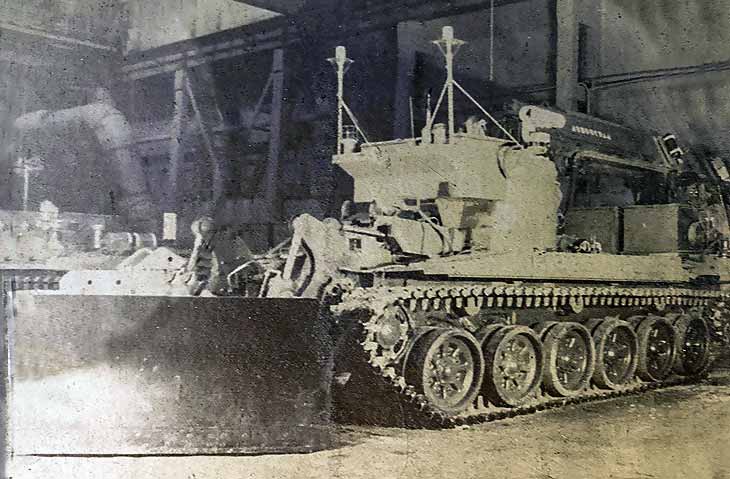
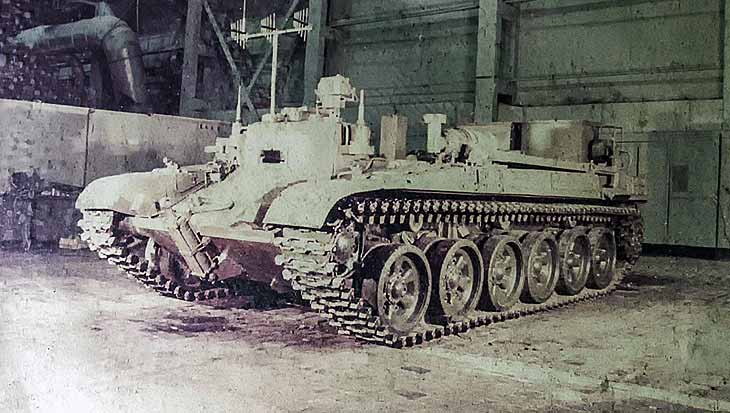
From top to bottom: Objects 032 and 033. The control machine was habitable and was in a safe place, while the radio-controlled bulldozer-deactivator worked in the most dangerous area. In total, the complex helped to remove, load into wagons and take out almost 1.5 thousand cubic meters of contaminated soil.
"Lunokhod" was also made. “Klin-2”, better known as “STR-1” or a specialized transport robot, turned out to be the most effective in terms of cleaning the roof of the 3rd power unit.
A car weighing almost a ton was delivered to the roof by helicopter or crane, and after work I stopped on a special platform and moved back along the same path back to the ground for decontamination and recharging. Engineers seriously approached the chassis so that the robot moved as efficiently as possible through the sticky heat (and in order to prevent erosion of radioactive contamination over a large area with wastewater from showers, the Carcass with silver iodide charges circled over the area for a long time) cover. It was necessary that the bitumen does not stick to the wheels, and at the same time that the wheels cling to it well, removing it from the roof along with the fused radioactive debris. With this task, two machines STR-1 coped, cleared by the end of September, more than 3000 square meters. m roof.
The radiation resistance of the components was manifested, firstly, in the inheritance of space technology - the experience of developing components that are protected from the action of cosmic rays has already been had. Secondly, trouble-free control methods were used: relay assemblies were used to the maximum in the circuitry itself, and remote control was carried out via secure radio channels.

In addition to the VNII-100, the machines of the Leningrad Central Research Institute RTC worked on accidents. They were more different sizes, but they were subject to significant criticism for poor handling, failures, slowness. Within the framework of this article, having been born after the events described and not being an expert, I will not undertake to say something strictly. From the sources I found, the son of Kemurdzhiana in his lecture on the 30th anniversary of the accident speaks of about 1,000 people (meaning shifts, equivalent to a set of one permissible single dose for the liquidator), which was replaced by STR-1. Valery Starodumov in the same movie released at the same time speaks about 800 people who were required to service the failed robots. I just recommend you to see both sources yourself, they are very interesting.
Remotely controlled self-propelled units appeared after the removal of debris and construction of the object "Shelter". They solved other tasks - the study of the state of the structures, the search for fuel (at first no one knew that in the former reactor core there was no graphite assembly and fuel cells left - everything melted and leaked into the sub-reactor space) and especially contaminated sites.
After the construction of the Shelter, at first no one used robots - the research of the premises was successfully conducted by drilling wells and introducing probes with the necessary sensors for exploration. Later, when the primary intelligence provided basic information about the location of fuel-containing materials (FCM) and the state of the structures, the robots began to actively develop and apply for obtaining new data and television pictures from the place of work.
Requirements for finished machines were as follows. In addition to radiation protection, moisture and dust protection was required. Under the “Shelter”, the climate was humid, and the radioactive dust required to cover the robots with a special cloth to facilitate deactivation. Reliability and maneuverability were provided by the unification of units, chassis, size reduction, the use of independent suspension of the trolley wheels. Remote control and reception of signals were conducted by cable - the radio signal was muffled by the station's concrete structures.
On the basis of standard chassis, robots were created for the following tasks:
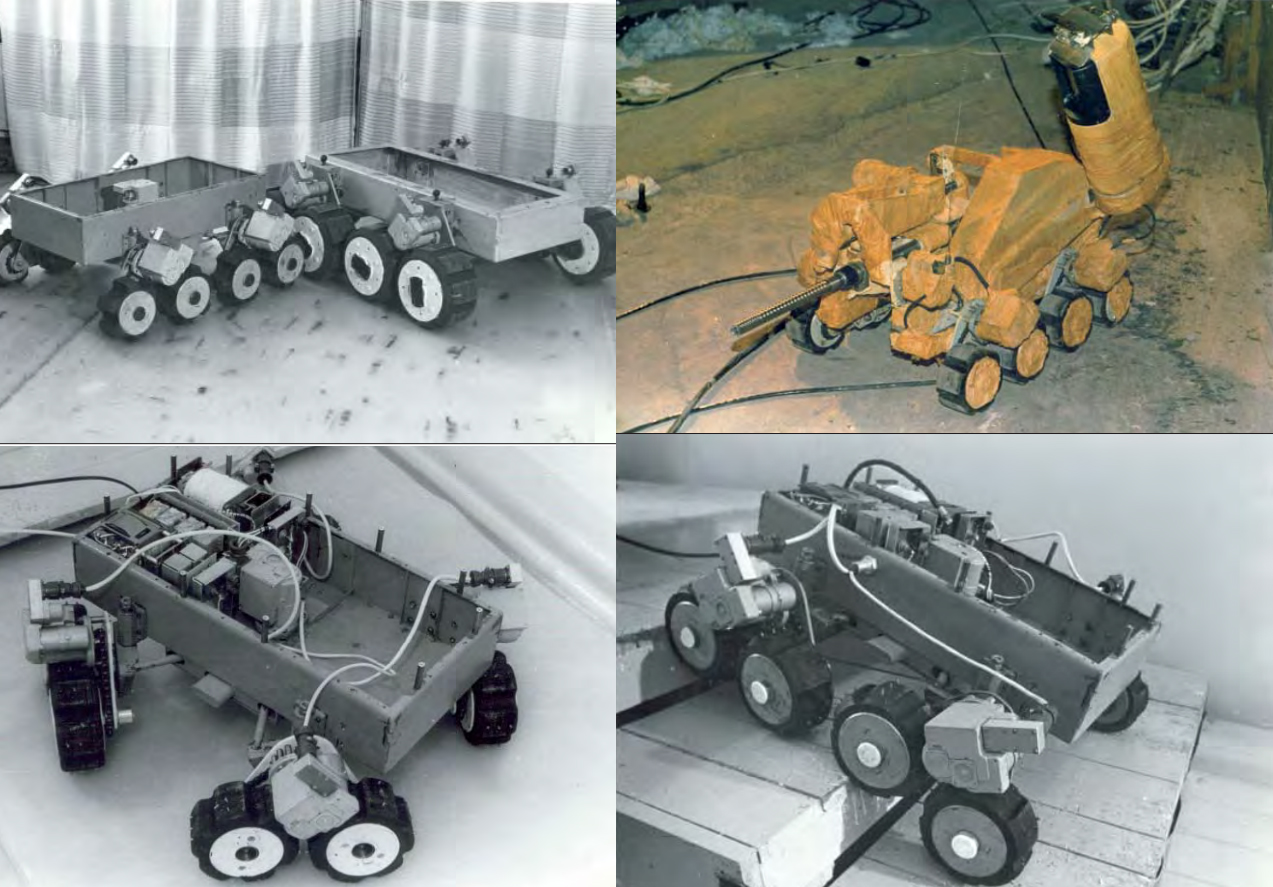
DUSA carts on trial. Pay attention to the insulating fabric. Photo source here and below
Interesting examples are also robots with special modes of movement. In the completely destroyed zone of the power unit, rails were laid along which the DOSA moved.
Moving in the air over the colossal destruction impassable for any kind of technology, the robot with a camera made it possible to map in great detail both the degree of damage to premises and structures, and the location of radioactive debris.
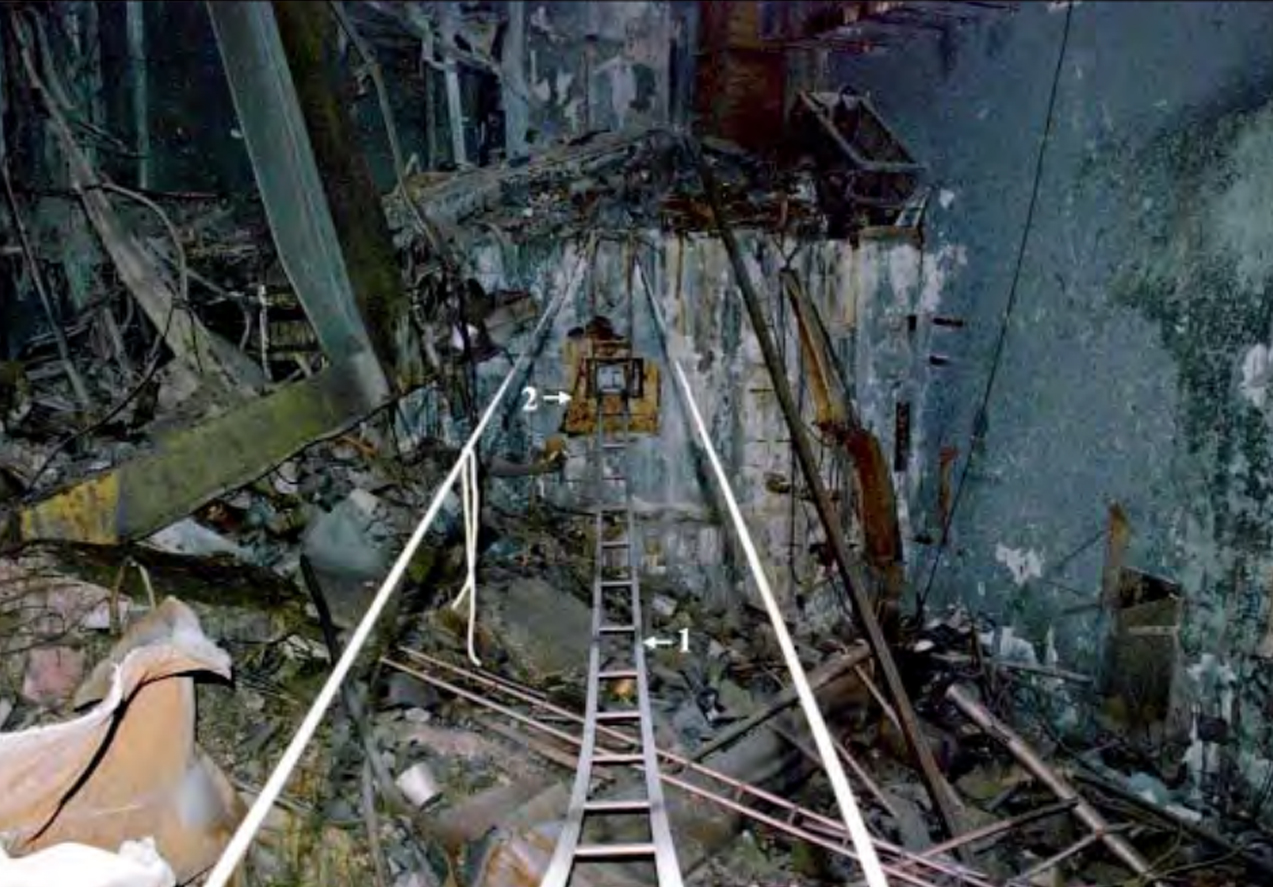
Absolutely exotic car was the magnetic duct. It was created to work on the walls and ceilings of rooms with a cladding that can magnetize. The robot's running nodes contained powerful samarium-cobalt magnets, which allowed the robot moving along this coating to carry considerable weight. Dual wheel units increased the reliability of engagement when overcoming welds and fragments of non-magnetic coatings. In 1990–91 The magnetic duct was tested in the laboratory and used at the Shelter to install thermal sensors in the rooms of the steam distribution corridor. In preparation for the stabilization of the Shelter's structures, he measured the dose fields on the northern buttress wall:
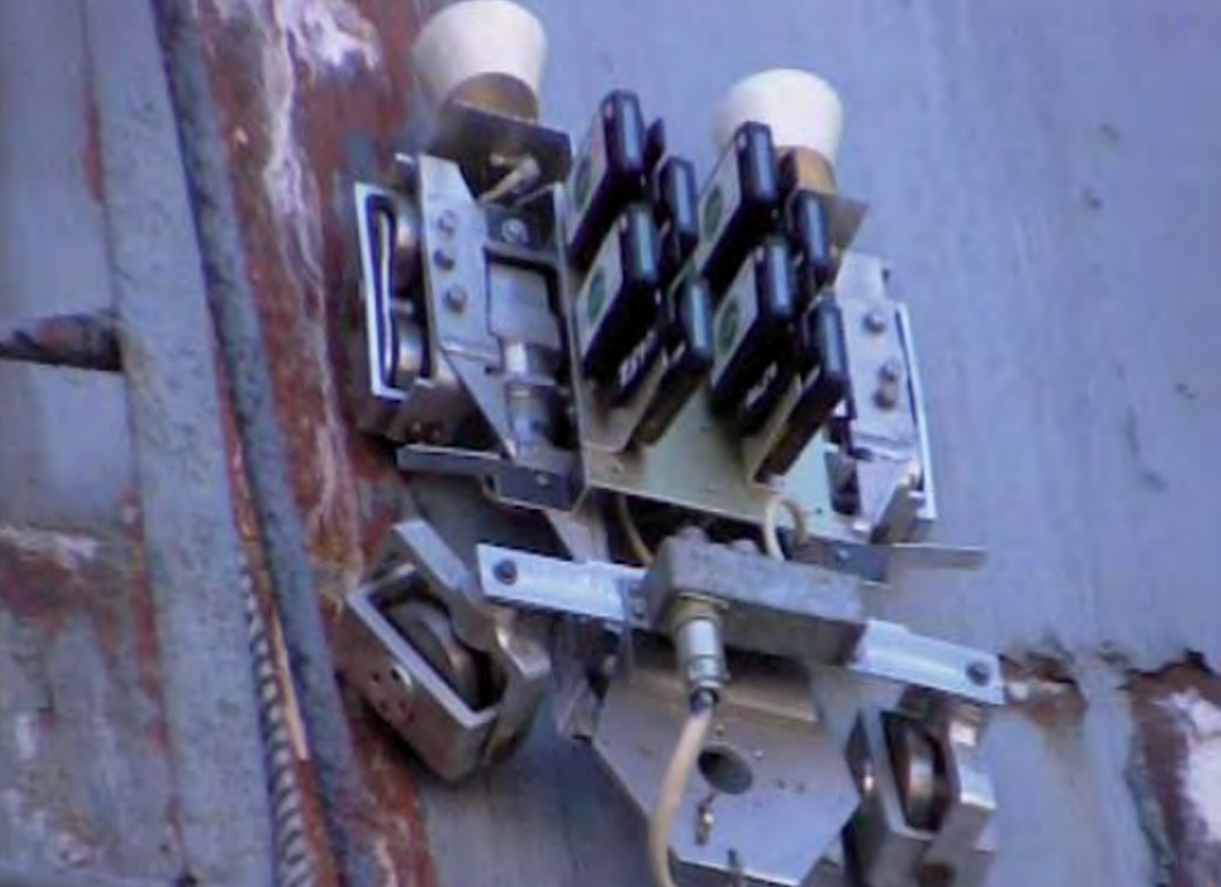
In more detail with all the technical characteristics of all these devices are described in this book: A.A. Borovoy, E.P. Velikhov. The experience of Chernobyl , and I do not see the need to reprint the material from there word for word, since that work covers many more aspects of the accident and is beautifully illustrated.
It is noteworthy that the robots still had to repeat this path after a quarter of a century on the other side of the globe in the well-known accident at Fukushima. And this path also turned out to be quite thorny.
The engineers who created the prototype dismantled the tower, installed a dosimeter, a temperature sensor, and an illuminator on the tank. The tank was equipped with a remote control, which was carried out by electric cable, in the same way received data from the installed tools. From the very first attacks, the tank proved to be very useful for radiation reconnaissance: launching it ahead of people, it was possible to inspect structures and measure the level of radioactive contamination promptly and without unnecessary risk for the liquidators. In addition, the car was very maneuverable and passable due to its small size, crawling among the rubble into the smallest and most inconvenient passages, and the plastic case was easily susceptible to subsequent cleaning and decontamination.
The tank was a toy, and it was one of the most successful robots created and applied at the emergency station.
')

Sad toys
There is such an Internet meme: at first glance, innocuous pictures with the caption "When you notice THIS - get it by fear."
In the photo above ( link to the source and the author ) everything seems cute: red, seemingly toy excavator is a childhood dream; the same dump truck: like a toy, but big and serious; between them is a silvery moonwalker. Probably, this is a playground of some school or summer camp, and the armored personnel carrier in the background is well, for patriotic education.
But no. The very “frightening detail” in the photo is a small triangular sign of radiation danger in front of a dump truck. This is the exposition of a small museum of equipment that took part in the liquidation of the accident , and the sign eloquently shows why the exhibits cannot be touched.
There is an opinion that when trying to use robots, they all very quickly failed, they chose to give up, and they began to clean the emergency station with "bare hands", that is, at the cost of the health and lives of numerous liquidators. In fact, this is a very controversial statement, with the direct participants in those events arguing among themselves. Indeed, directly during the work of extinguishing, cleaning the roof, decontamination and dismantling of debris robots could not fully replace people. They had their own serious drawbacks such as problems with overcoming debris and dusting while moving. However, their contribution was nevertheless significant - for the two months, the notorious roof of the 3rd power unit removed 50 tons of sticky bitumen-ruberoid coating, which absorbed large amounts of radioactive dust, and a little less - graphite fragments, the second most dangerous material of the reactor after FCM - fuel-containing materials, as they called ceramics or lava from hardened molten concrete and fuel elements. Later, when it came to conservation, monitoring the condition of the destroyed power unit and work inside the Shelter — that is, when there was no need for emergency and dangerous work of hundreds of people at the same time — it was time for robots.
Do not uneasy?
It seems counterintuitive that metal inanimate robots suffer from radiation. But in reality it is like this: the failure of electronic components under the action of radioactive radiation occurs much faster than the same radiation destroys a living organism. Small deadly shells will long bombard a person inside and outside (with ingested or inhaled dust, or from neutron guidance) before painful death occurs; but electronics, being in the limit of binary logic, immediately fails with the smallest, but critical violation.
Of course, in conditions of prolonged low-intensity irradiation, the robot will benefit. But with hundreds and thousands of X-rays an hour on the edge of the collapsed roof of the Chernobyl nuclear power plant, it will very quickly fail its weakest link: semiconductors. Semiconductors are both microcircuits and the simplest transistors that suffer from irradiation for exactly the same reason that they work: the transfer of charge carriers in the semiconductor material is disturbed by radioactive charge carriers penetrating the body of the robot.
Under the deadly shower of charged particles, there are two main mechanisms of damage to electronics.
First, neutrons, protons and alpha particles damage the crystal lattice of a semiconductor , replacing atoms with isotopes or even other elements, causing local defects. This greatly affects the mobility of charge carriers, the number of recombinations, as well as the properties of the pn junction in transistors. Interestingly, short-term high-energy irradiation causes a “tempering effect”, called by analogy with metal quenching: the lattice is slightly restored compared to degradation caused by continuous, but less powerful radiation. However, for bipolar transistors, this factor becomes the main cause of loss of output characteristics.
Secondly, particles with less energy than is required for atomic substitutions in the crystal lattice cause ionization effects. This translates into all sorts of electrical noise, induced noise, photo effect and signal transmission errors in optocouplers, degradation of MOS transistors, as well as software malfunctions.
Separate from all types of irradiation are neutrons, capable of both the above interaction with atomic nuclei in a crystal and the generation of secondary radiation — shrapnel from collisions with the material. Bipolar transistors are most sensitive to them, because penetrating into the crystal lattice, neutrons can create “deep traps” in it, that is, places with an abnormally large forbidden zone - energy to transfer the charge carrier to the level of conductivity. They maintain the flux density up to the order of giant-neutrons per square meter. cm, CMOS circuits - petaneutrons per square. see. In general, CMOS chips can withstand a dose of up to 100 gray radiation. For comparison, about 5 Gray is a lethal dose for a person, and considering that Gray is the number of joules of radiation per kg of mass and the difference between the masses of a microcircuit and a person, this looks quite good. As long as the robot does not fall under the effect of thousands of x-rays per hour. But there are technologies that allow to increase the stability of a semiconductor crystal to radiation by orders of magnitude, for example, growing it on a sapphire substrate . It is also possible and circuit, and logical (increase in the number of control bits) increase the reliability of electronic systems.
Wedge
At first, the robots worked in parallel with the liquidators. Both on the ground and on the roof of the station, where the ground or the ruberoid flooring and concrete crumb were mixed with real mines in the form of fragments of graphite assembly and fuel cells, it was necessary to carry out decontamination work as soon as possible.
One of the first to start work was remotely controlled complexes produced by VNII-100 (now VNIITransmash). Already on May 18, the chief commissioner Alexander Leonovich Kemurdzhian , who was urgently brought into the disaster zone, was demanded by the government commission: “You made a remotely operated Lunokhod country — put it on the roof so that it would clean it!”. In response to irritated objections that the Lunokhod was not adapted for these tasks, Kemurdzhian received an even more categorical answer: “Then make us a new car!”
New cars were made in a very short time. First of all, in just 44 days, the Klin-1 was created. It was a calculation of two tracked vehicles: a grader Object 032, created on the basis of an engineering machine for lining the IMR-1 with additional decontamination equipment, shielding and a radio control system, as well as a management machine Object 033 on the basis of the T-72 tank.


From top to bottom: Objects 032 and 033. The control machine was habitable and was in a safe place, while the radio-controlled bulldozer-deactivator worked in the most dangerous area. In total, the complex helped to remove, load into wagons and take out almost 1.5 thousand cubic meters of contaminated soil.
"Lunokhod" was also made. “Klin-2”, better known as “STR-1” or a specialized transport robot, turned out to be the most effective in terms of cleaning the roof of the 3rd power unit.
A car weighing almost a ton was delivered to the roof by helicopter or crane, and after work I stopped on a special platform and moved back along the same path back to the ground for decontamination and recharging. Engineers seriously approached the chassis so that the robot moved as efficiently as possible through the sticky heat (and in order to prevent erosion of radioactive contamination over a large area with wastewater from showers, the Carcass with silver iodide charges circled over the area for a long time) cover. It was necessary that the bitumen does not stick to the wheels, and at the same time that the wheels cling to it well, removing it from the roof along with the fused radioactive debris. With this task, two machines STR-1 coped, cleared by the end of September, more than 3000 square meters. m roof.
The radiation resistance of the components was manifested, firstly, in the inheritance of space technology - the experience of developing components that are protected from the action of cosmic rays has already been had. Secondly, trouble-free control methods were used: relay assemblies were used to the maximum in the circuitry itself, and remote control was carried out via secure radio channels.

In addition to the VNII-100, the machines of the Leningrad Central Research Institute RTC worked on accidents. They were more different sizes, but they were subject to significant criticism for poor handling, failures, slowness. Within the framework of this article, having been born after the events described and not being an expert, I will not undertake to say something strictly. From the sources I found, the son of Kemurdzhiana in his lecture on the 30th anniversary of the accident speaks of about 1,000 people (meaning shifts, equivalent to a set of one permissible single dose for the liquidator), which was replaced by STR-1. Valery Starodumov in the same movie released at the same time speaks about 800 people who were required to service the failed robots. I just recommend you to see both sources yourself, they are very interesting.
DUSA
Remotely controlled self-propelled units appeared after the removal of debris and construction of the object "Shelter". They solved other tasks - the study of the state of the structures, the search for fuel (at first no one knew that in the former reactor core there was no graphite assembly and fuel cells left - everything melted and leaked into the sub-reactor space) and especially contaminated sites.
After the construction of the Shelter, at first no one used robots - the research of the premises was successfully conducted by drilling wells and introducing probes with the necessary sensors for exploration. Later, when the primary intelligence provided basic information about the location of fuel-containing materials (FCM) and the state of the structures, the robots began to actively develop and apply for obtaining new data and television pictures from the place of work.
Requirements for finished machines were as follows. In addition to radiation protection, moisture and dust protection was required. Under the “Shelter”, the climate was humid, and the radioactive dust required to cover the robots with a special cloth to facilitate deactivation. Reliability and maneuverability were provided by the unification of units, chassis, size reduction, the use of independent suspension of the trolley wheels. Remote control and reception of signals were conducted by cable - the radio signal was muffled by the station's concrete structures.
On the basis of standard chassis, robots were created for the following tasks:
- Deactivation. The robot drove into the room, spraying a decontamination solution there with the help of a hose and a nozzle and then applying a dust cover to the walls, the ceiling and the floor.
- Concrete sampling. Robots with manipulators were created that made it possible to drill walls and samples of solidified melt of fuel and structures for collecting samples for the purpose of subsequent analysis.
- TV intelligence. For the assessment of damage caused by the explosion, as well as for the production of many works, including other space-throwing devices, specialized observation vehicles were created with powerful light sources and video cameras mounted on them.

DUSA carts on trial. Pay attention to the insulating fabric. Photo source here and below
Interesting examples are also robots with special modes of movement. In the completely destroyed zone of the power unit, rails were laid along which the DOSA moved.
Moving in the air over the colossal destruction impassable for any kind of technology, the robot with a camera made it possible to map in great detail both the degree of damage to premises and structures, and the location of radioactive debris.

Absolutely exotic car was the magnetic duct. It was created to work on the walls and ceilings of rooms with a cladding that can magnetize. The robot's running nodes contained powerful samarium-cobalt magnets, which allowed the robot moving along this coating to carry considerable weight. Dual wheel units increased the reliability of engagement when overcoming welds and fragments of non-magnetic coatings. In 1990–91 The magnetic duct was tested in the laboratory and used at the Shelter to install thermal sensors in the rooms of the steam distribution corridor. In preparation for the stabilization of the Shelter's structures, he measured the dose fields on the northern buttress wall:

In more detail with all the technical characteristics of all these devices are described in this book: A.A. Borovoy, E.P. Velikhov. The experience of Chernobyl , and I do not see the need to reprint the material from there word for word, since that work covers many more aspects of the accident and is beautifully illustrated.
It is noteworthy that the robots still had to repeat this path after a quarter of a century on the other side of the globe in the well-known accident at Fukushima. And this path also turned out to be quite thorny.
Source: https://habr.com/ru/post/449724/
All Articles